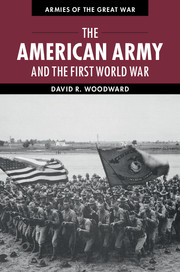Book contents
- Frontmatter
- Dedication
- Contents
- List of figures
- List of maps
- List of tables
- Preface
- List of abbreviations
- Introduction
- 1 Birth of a modern army
- 2 World war and American preparedness
- 3 Coercive power and Wilsonian diplomacy
- 4 “You’re in the army now”
- 5 US army doctrine and industrialized trench warfare
- 6 Over where?
- 7 American Expeditionary Force organization, overseas training, and deployment
- 8 Will the Americans arrive in time?
- 9 Failed expectations: “the military establishment of the United States has fallen down”
- 10 Atlantic ferry
- 11 Neck of the bottle
- 12 Uncertain times
- 13 Cantigny
- 14 Into the breach
- 15 American soldiers in north Russia and Siberia
- 16 The beginning of the end
- 17 Establishment of the American First Army and Saint-Mihiel
- 18 Meuse-Argonne, September 26–October 31
- 19 Breakout, November 1–11
- 20 Epilogue
- Notes
- Bibliography
- Index
18 - Meuse-Argonne, September 26–October 31
Published online by Cambridge University Press: 05 July 2014
- Frontmatter
- Dedication
- Contents
- List of figures
- List of maps
- List of tables
- Preface
- List of abbreviations
- Introduction
- 1 Birth of a modern army
- 2 World war and American preparedness
- 3 Coercive power and Wilsonian diplomacy
- 4 “You’re in the army now”
- 5 US army doctrine and industrialized trench warfare
- 6 Over where?
- 7 American Expeditionary Force organization, overseas training, and deployment
- 8 Will the Americans arrive in time?
- 9 Failed expectations: “the military establishment of the United States has fallen down”
- 10 Atlantic ferry
- 11 Neck of the bottle
- 12 Uncertain times
- 13 Cantigny
- 14 Into the breach
- 15 American soldiers in north Russia and Siberia
- 16 The beginning of the end
- 17 Establishment of the American First Army and Saint-Mihiel
- 18 Meuse-Argonne, September 26–October 31
- 19 Breakout, November 1–11
- 20 Epilogue
- Notes
- Bibliography
- Index
Summary
At the beginning of September, Pétain, agreeing with most Allied political and military leaders, thought that Germany had the capacity to continue the war into 1919 even if the Allies breached the Hindenburg Line. French intelligence identified a series of new German defensive positions still to be overrun. And the arrival of winter might give the exhausted German Army a respite to rest and reinforce its spent divisions. On September 8, the French commander-in-chief wrote the following: “When the battle commences again in 1919 our adversary undoubtedly will be established behind a strongly fortified front, abundantly supplied with means of defending against tanks and covered by a deep zone of advance posts or by lines of water.” American manpower made Pétain confident of ultimate victory but he placed even greater emphasis on the growing material disparity between the opposing armies. “The battle of 1919,” he predicted, “will be a battle of aviation and tanks.”
With Allied forces maintaining the offensive initiative, however, September turned out to be a calamitous month for Germany’s military fortunes. Berlin had begun the month with more than 2.5 million men in uniform and all of its allies still in the war. Gray-clad infantry occupied more French and Russian territory than they had during the previous September and possessed the strongest defensive system on the Western Front, which remained intact. But setback followed setback, and Ludendorff’s darkening mood mirrored the bleak prospects facing German soldiers by the end of the month.
- Type
- Chapter
- Information
- The American Army and the First World War , pp. 323 - 354Publisher: Cambridge University PressPrint publication year: 2014

